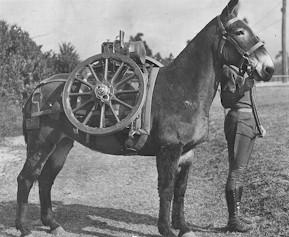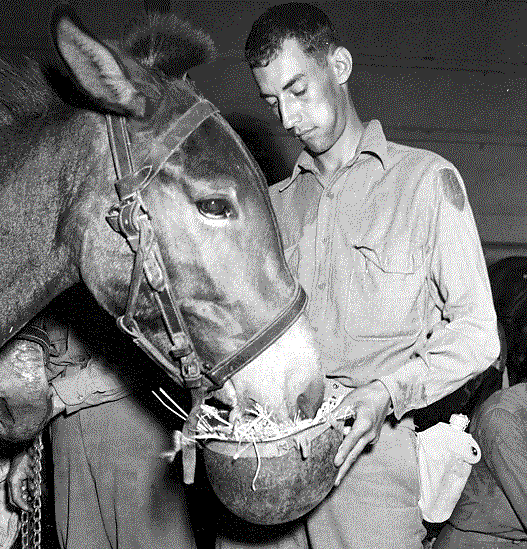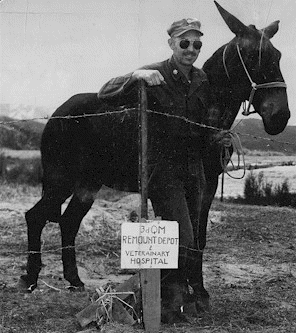The Early Days
The procurement and training of animals for military use has been a function of the Quartermaster Department since its inception in 1775. Animals were used for transporting supplies and men prior to the use of motor vehicles. At that time, transportation overland meant movement by horses, mules, and oxen. The purchase or hiring of horses and wagons, and finding forage for the animals, were major headaches for the early Quartermaster Generals.
The first Quartermaster General, General Thomas Mifflin, told Congress in 1776 that to perform his mission he would need: “200 wagons with four horses each, 50 ox teams with two oxen each; and 50 drays with, one horse each, besides 100 strong horses for the artillery, and 50 for expresses and commissary.”
In 1778, Congress adopted General Mifflin’s plan for reorganization of the Quartermaster Department and included “a commissary of forage” and “a commissary for horses and wagons” as two of the major officials.
Remount Service
In 1908, Congress authorized the Remount Service, which was to procure horses, condition them, provide initial training, and issue them to using units. Before that time, horses and mules for Army use had been purchased by the Quartermaster Department under contract after advertising for bids. This practice had been quite unsatisfactory in terms of getting a number of older horses, many in poor physical condition. The first remount depot was at Fort Reno, Oklahoma. The Front Royal, Virginia, Depot was opened in 1911.

The principle function of the Remount Service during peacetime was to procure, process, train, and issue horses, mules, and dogs (1942-1948) for military use and to train personnel in animal management. It was also responsible for purchase of forage for these animals. Another function of the Remount Service was that of supervising the Army horse breeding program designed to raise the quality of horses.
The Remount Service’s principle functions during war were to supply replacement riding horses and the draft animals required to haul ammunition, water, food, and heavy artillery and to evacuate the wounded. Motorization and mechanization in the 1930s reduced the need for animals, but did not make them completely obsolete.
World War I
World War I was the last major conflict which the United States Army used horses and mules in significant numbers. The Remount Service was enlarged to meet the increased demands of the Artillery, the Cavalry and other units. Around 571,000 horses and mules processed through the Remount system of which more than 68,000 were killed in that war. At the close of the war the Quartermaster Corps maintained 39 remount depots with a capacity 229,200 animals.
Breeding Program
A breeding program originated in 1919 when the War Department created the Remount Board consisting of prominent civilian horsemen and Army officers to make recommendations for regulating and supervising the breeding of horses. In 1921, the Remount Service assumed total responsibility for the horse breeding program from the Department of Agriculture.
For the purposes of breeding and purchasing operations, the United States was divided into geographical regions each with a Remount Depot. At the beginning of World War II there were seven depots, but reduction in need resulted in six locations by 1944 Front Royal, Virginia; Lexington, Kentucky; Sheridan, Wyoming; San Angelo, Texas; Colorado Springs, Colorado; and Pomana, California. The Pomana depot was donated to the Army by W. C. Kellogg, a fancier of Arabian horses. Mr. Kellogg hoped that the Army would continue his efforts to perpetuate good Arabian stock.
The Remount Service performed several functions in the area of horse breeding. The breeding farms were selected as carefully as the animals themselves. Civilian breeders contracted with the Army to breed horses. Records indicate that the Army purchased approximately 75% of the foals resulting from the breeding program, although it assumed no responsibility to purchase foals or pay expenses related to the care and maintenance of breeding stock. The Army horse breeding plan continued throughout World War II. Approximately 39,000 foals were produced during the war years. In 1948, congress transferred the breeding program to the Department of Agriculture. The breeding program was discontinued in 1949 and the remaining stock and equipment was sold by the Department of Agriculture.
World War II

World War II saw the mechanization of the Army. The transportation of supplies, equipment & personnel was primarily conducted with motor vehicles. The horse lost its prominence as a mode of transportation, however mules continued to have great value due to their ability to negotiate rugged terrain inaccessible by vehicles. This fact was proven in the mountains of Italy and jungles of Burma.
When mobilization for World War II began in 1939, it was predicted that the Army would need 200,000 horses. (In 1940, the Army had 2 horse cavalry divisions, 2 horse-drawn artillery regiments, and 2 mixed horse and motor transport regiments, with a total authorization of 16,800 horses and 3,500 mules.) The need for horses continuously decreased as active, reserve and National Guard units converted to trucks and jeeps. These horses were returned to the remount depots. Only four horses were procured in the 1943 fiscal year and none from then on through the end of the war. Throughout the war period only 49 horses were shipped from the United States to the armed forces overseas.
There was an unexpected demand in 1943 from the Coast Guard for 3,000 horses to be used by its beach patrols. The Coast Guard patrolled the shores for hostile submarine activity. By 1944 however, the danger ceased and the horses were returned to Remount Depots.
In 1944 and 1945, approximately 14,000 mules were used. Mules could negotiate jungle or mountainous terrain that no horse or vehicle could traverse. Pack mules were used by US forces in Tunisia during the winter of 1942-43 and were employed extensively in the rugged mountain terrain of Italy. In the spring of 1945 the 10th Mountain Division employed thousands of mules in rugged terrain of northern Italy during its drive through the North Apennines mountains and the Po Valley. Animal pack outfits were also used in the China-Burma-India theater especially during the active combat operations in Burma. Very often the Army would procure animals in the theaters where the troops were operating and in emergencies would commandeer animals on the spot.
Remount Service Inactivated

The Remount Purchasing and Breeding Headquarters Offices were closed and the Army Horse Breeding Program was transferred to the Department of Agriculture by Act of Congress on 1 July l948, along with the Remount Depots, equipment and breeding stock. The Program was liquidated by the Department of Agriculture the following year and all stocks sold at public auction.
Korean War
Horses and mules captured from the Chinese and North Koreans utilized for pack transportation. As an interesting sidelight, one of the animals being used was a former US mule about whose identity there was not the slightest doubt. His Preston Brand was 08K0 (See photo at right). He was one of the many mules shipped to Chine-Burma-India theater during World War II and later commandeered by the Chinese Army.
End of an Era
Two animal pack units, the 4th Field Artillery Battalion and the 35th QM Pack Co., equipped with mules and a small number of horses were retained at Fort Carson, Colorado, for training purposes to insure a means of expansion in case of emergency.
These two pack units were inactivated on 15 February l957, and all of the animals were sold or transferred to other Government agencies, including the Forest Service of the Department of Agriculture and the National Park Service of the Department of the Interior. In ceremonies befitting and honoring the long service of this patient but sometimes cantankerous Army animal, the mules were publicly mustered out of the Army, to be replaced by the helicopter.
Upon retirement of the colors and guidons, “Trotter” and “Hambone”, mules from each of these units, were brought before the commanding general, and each was given a citation.
The Army still uses horses for ceremonial purposes and in military funerals at Arlington National Cemetery. The U.S. Military Academy at West Point, New York uses the mule as its mascot.
The U.S. Army Quartermaster Museum at Fort Lee, Virginia has an extensive display of Quartermaster Remount equipment.
Compiled from the Archives of the U.S. Army Quartermaster Museum, Fort Lee, Virginia.
by K. M Born Last Updated: January 08, 2007
World War I Quartermaster Sergeant Wins Distinguished Service Cross
Dr. Steven E. Anders, Quartermaster Corps Historian
In 1917 and 1918 when the U.S. Army went off to fight in France in World War I, thousands of Logistics Warriors from the Quartermaster Corps joined their combat arms brethren in the trenches along the Western Front. They added to the glorious reputation of the Corps.
Take for instance, the case of Laurence M. Lumpkin of Danville, Virginia. He was a Quartermaster sergeant in Pack Train Number 1 working near Exermont, France, with the First Division, AEF, on October 4, 1918. Sergeant Lumpkin’s pack train, loaded with sorely needed wire for the forward elements of the “Fighting First” suddenly found itself in the proverbial X-marks-the-spot in Argonne. Without warning, German batteries opened up. The terrain afforded virtually no concealment.
After artillery fire came direct fire from the German machine-gunners and snipers. Sergeant Lumpkin lost 5 of the 10 mules in his train. Even so, he knew how desperately that wire in this train was needed at the front. He pushed on shoving his pack train through the killing fire, and made the final dash forward in safety. Later in the same action, he took a second load of wire forward, under fire. For his heroism that day, Sergeant Lumpkin was awarded the Distinguished Service Cross–the second highest honor that cam be won in combat.
From the Quartermaster Professional Bulletin-Autumn 1992
